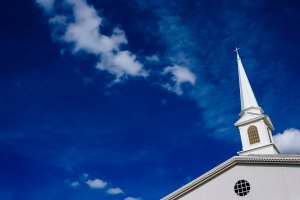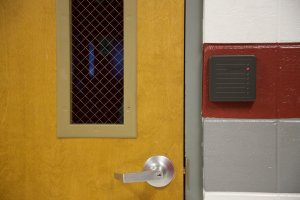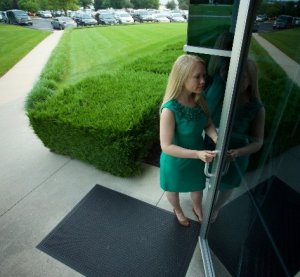
Securing a place of worship is a delicate issue. We want our worship facilities to be welcoming and a place where people can enjoy a sense of belonging and community. Security cameras, access control and alarm equipment visible for all to see can be off-putting and a reminder of the crime and violence prevalent in our world. It’s important to find the right system that addresses the key security concerns but doesn’t take away the sense of community leaders work so hard to foster.
Where to concentrate your efforts to secure your place of worship? The following is intended to be a guideline to get you started.
LAYER 1
- Door Status Monitoring. All exterior doors should be electronically monitored for both door position and latch position; this allows staff to understand remotely if an opening is secure by knowing if a door is closed and latched. It is especially important to monitor main entrance doors if the secured vestibule is not in direct view of the office or monitoring station.
 Electronic Access Control of Primary Entrances. Exterior doors that are considered primary entrances should have electronic access control, both to limit the distribution of keys and to enhance the ability to control who can gain access to a specific building and when. Access control systems also provides the ability to generate reports of user and system activity.
Electronic Access Control of Primary Entrances. Exterior doors that are considered primary entrances should have electronic access control, both to limit the distribution of keys and to enhance the ability to control who can gain access to a specific building and when. Access control systems also provides the ability to generate reports of user and system activity.- Video Intercom at Visitor Entrance Points. Often places of worship are unoccupied except for office staff and clergy. If practical, lock all entry points to the building and install a video intercom at the main visitor entry point(s). These devices enable staff to speak with and observe visitors at the main entrance and any other areas, such as loading docks, where people other than staff need to enter the building. The use of networked video intercoms is recommended, enabling screening from multiple devices such as a monitor in the front office or on mobile devices if needed. The intercom should be integrated with an electronic access control system to enable screeners to unlock the door remotely.
- Interior, Fixed Camera Coverage for ALL Entrance Points. All video surveillance systems should provide a visual record of people entering the facility. Every exterior door should be included, even if it is always locked, since it can easily be propped from the inside to let someone enter the building, bypassing the requirement for screening at the main entrance.
- Interior, Fixed Camera Coverage for ALL Childcare and Play Areas. Cameras act as a deterrent to those with bad intent as well as a record of events should there be an incident.
- Electronic Access Control of ALL Childcare and Play Areas. Doors accessing Childcare and Play areas should have electronic access control to limit access to only authorized individuals. Access control also provides the ability to create an audit trail should the need arise.
LAYER 2
- Interior, Fixed Camera Coverage for All Common Areas. Cameras should be positioned to monitor all common areas such as hallways and gathering areas. This is to provide deterrence, safety for the members, staff, and recordings of events of violence, slips and falls, and general bad behavior.

- Exterior, Fixed Camera Coverage at All Entry Points. Cameras should be mounted on the exterior wall of the building pointed towards all entry/exit points in a way that provides the widest possible field of view of the area. In many cases, this will result in a profile view of people exiting the building. This may also aid in providing a visual record of people loitering at exits and recordings of people entering the facility through entry points other than the main entry.
- Exterior, Fixed Camera Coverage of Parking Lots. Cameras should be mounted on the exterior wall of the building and pointed towards the parking areas to monitor theft from vehicles, vandalism, damage from snow plows and slips and falls. If license plates are to be captured, use cameras designed for that purpose and place to monitor entry and exit points to the property.
This is not intended to be a comprehensive guide to secure a place of worship. There is much more that can be done through policies, procedures, and people to aid in preventing, detecting and responding to the various security threats places of worship face. The above guidelines are intended to aid in designing an electronic approach to security. As always, its best to consult companies that specialize in securing places of worship for a customized solution to the security threats you might be facing.

